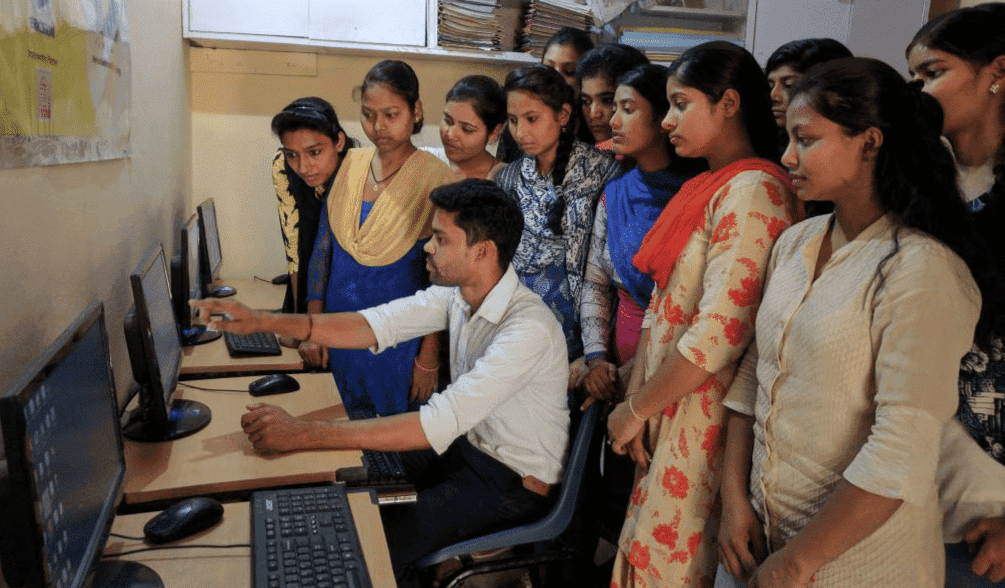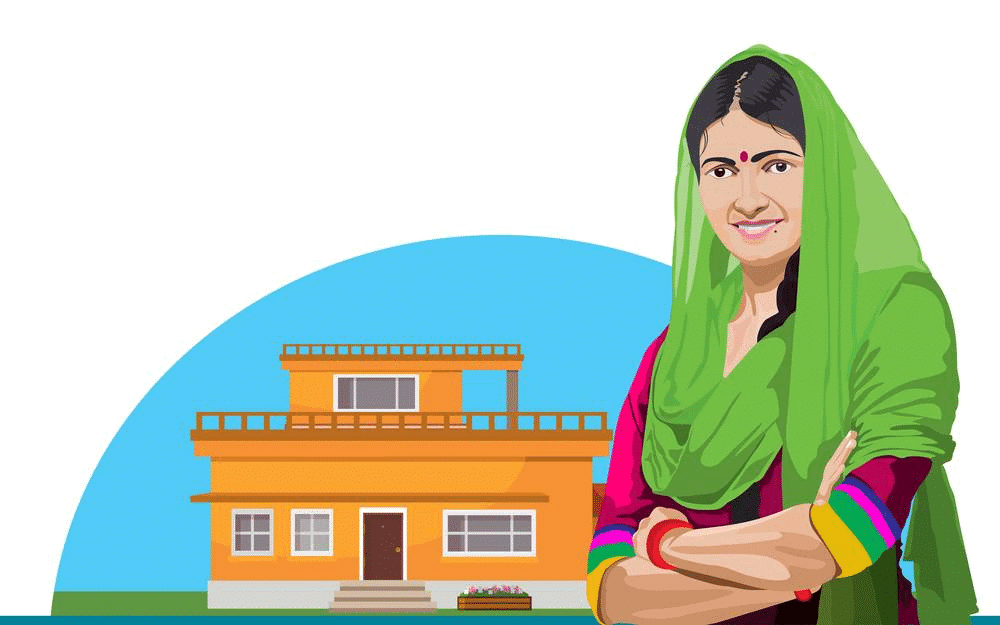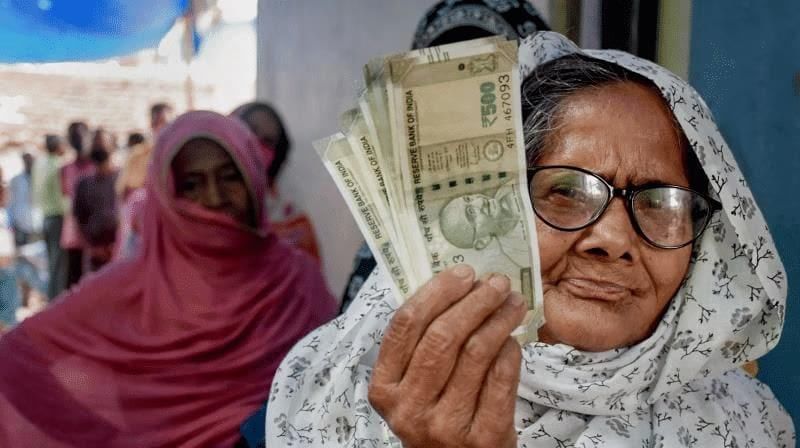Rural Development Programme - 1 | Indian Economy for UPSC CSE PDF Download
Integrated Rural Development Programme (IRDP)
IRDP's objectives are:
- Reduction of unemployment in rural areas;
- Provision of assets, inputs for rural poor to cross the poverty line.
Salient Features
- The IRDP was started in 1978-79 in 2300 development blocks as a programme of total development covering small and marginal farmers, agricultural labourers, and rural artisans with an annual income of less than Rs. 11,000 throughout India. It has since evolved into the Deen Dayal Antyodaya Yojana - National Rural Livelihoods Mission (DAY-NRLM) in 2015, which continues to target rural poverty alleviation as of 2025.
- It was implemented by District Rural Development Agencies (DRDA), a mechanism retained under DAY-NRLM for grassroots execution.
- Under this programme, central funds were passed on to the state government for covering selected rural families living below the poverty line; this funding model persists under DAY-NRLM with enhanced allocations.
- The sharing between the centre and states was 50:50, now adjusted under DAY-NRLM to reflect varying state capacities.
- Under the programme, subsidy provision of 25% for small farmers, 33½% for marginal farmers, agricultural labourers and rural artisans, 50% for SCs/STs and physically handicapped was made; DAY-NRLM enhances this with tailored financial inclusion schemes.
- Selection criterion of the poor was based on the Antyodaya principle, i.e., poorest of poor first, a principle still guiding DAY-NRLM's targeting.
- About 490 selected families benefited from it since the inception of the programme; DAY-NRLM has scaled this to millions through self-help groups (SHGs).
- IRDP has two components: Training of Rural Youth for Self Employment (TRYSEM) and Development of Women and Children in Rural Areas (DWCRA), now integrated into DAY-NRLM's skill and empowerment initiatives.
Shortcomings
This programme suffered from lack of competence, integrity, and training, reflected in beneficiary selection and infrastructure gaps. In 1999, IRDP was subsumed under Swarnjayanti Gram Swarozgar Yojana (SGSY), restructured into NRLM in 2011, and became DAY-NRLM in 2015. As of 2025, DAY-NRLM addresses these issues with robust SHG frameworks, skill training, and digital tools.
Training of Rural Youth for Self-Employment (TRYSEM)
- A centrally sponsored scheme for self-employment, it was launched on August 15, 1979, now integrated into DAY-NRLM as of 2025.
- The objective of the scheme was to provide training in skills and entrepreneurship to rural youth between the age group of 18 to 35 years belonging to families below the poverty line, a goal continued under DAY-NRLM's skill programs.
- Proposed to cover 2 lakh youths per year, now scaled up significantly under DAY-NRLM's broader reach.
- Covered 40 youth per block belonging to families with annual income less than Rs. 3500, now updated to current poverty metrics under DAY-NRLM.
- 50% reservation for SC/STs and 40% for women was provided for the training, policies retained and expanded under DAY-NRLM.
- During training stipends and free improved tool kits were provided to the trainees; DAY-NRLM offers similar support with modern resources.
 Training Centre
Training Centre
Development of Women & Children in Rural Areas (DWCRA)
- It was started in September 1982 as a component of IRDP, now part of DAY-NRLM’s women empowerment initiatives as of 2025.
- It aimed at providing training in skills and entrepreneurship to women members in the age group of 18 to 35, belonging to families below poverty line, now expanded under DAY-NRLM’s Mahila Kisan Sashaktikaran Pariyojana (MKSP).
- Women members of targeted families could take benefits of loan and subsidy under IRDP, now facilitated through DAY-NRLM’s SHG financing.
- The scheme was executed by DRDA, a structure retained under DAY-NRLM.
- To facilitate the implementation of the scheme, the policy of making groups of 10-15 women was adopted, a model scaled up under DAY-NRLM’s SHG framework.
- A revolving fund of Rs. 25,000 was provided to each women group to meet the needs of their working capital from the year 1995-96, now enhanced under DAY-NRLM with contributions from centre and state.
National Rural Employment Programme (NREP)
- It was launched in 1980 but got an impetus in 1981 when it became a regular part of the Sixth Plan, later merged into MGNREGA in 2005.
- It aimed at generating additional gainful employment, creating productive community assets to strengthen rural infrastructure, and improving nutritional standards, objectives now pursued under MGNREGA as of 2025.
- Was implemented as a centrally sponsored scheme on 50:50 sharing basis between the centre and the states, now adjusted under MGNREGA’s funding model.
- It was implemented through DRDA, a mechanism continued under MGNREGA.
- For the first time Panchayati Raj institutions were involved in the execution of an employment generation programme, a practice strengthened under MGNREGA.
- In 1989 merged with JRY, and subsequently into MGNREGA, which guarantees 100 days of wage employment as of 2025.
Rural Landless Employment Guarantee Programme (RLEGP)
- Was launched on August 15, 1983 as 100% centrally sponsored scheme at the mid-term appraisal of Sixth Plan, now part of MGNREGA as of 2025.
- Its main objective was improving and expanding employment opportunities for the rural landless by providing guarantee of employment to at least one member of every landless household up to 100 days in a year and creating durable assets, now a core feature of MGNREGA.
- The programme was continued during the Seventh Plan. Indira Awas Yojana launched on October 2, 1985 was a sub-scheme of RLEGP, now standalone under PMAY-G.
- It was merged with JRY in 1989, and later into MGNREGA, a flagship program as of 2025.
Jawahar Rozgar Yojana (JRY)
- Was started in April 1989 by merging wage employment schemes NREP and RLEGP, later subsumed into MGNREGA in 2005.
- Evaluation of previous programmes showed that only 55 percent of villages had got benefits of any works programme, therefore JRY targeted to benefit each village, a goal advanced by MGNREGA as of 2025.
- Primary objective was generation of additional gainful employment for rural poor, now ensured under MGNREGA’s 100-day guarantee.
- Secondary objective was creation of a viable rural economic infrastructure, now a key focus of MGNREGA and PMGSY.
- Main thrust was on placing funds in the hands of Panchayats, a practice strengthened under MGNREGA.
- Expenditure was shared by centre and state governments on 80:20 basis, now adjusted under MGNREGA’s funding structure.
- Preference was given to SCs and STs in employment, also 30% reservation for women, policies retained under MGNREGA.
- Non-wage component restricted to a maximum of 50% of the total allocated funds, a principle guiding MGNREGA’s asset creation.
- Allocation to states was done on the basis of incidence of poverty, direct disbursement of central assistance to districts, now streamlined under MGNREGA.
- Preference was given to works benefiting poverty groups like Indira Awas Yojana (IAY) and Million Well Scheme (MWS), now under PMAY-G and PMKSY.
- Higher priority to works for infrastructure of other poverty alleviation programmes like IRDP, DPAP, DDP, now integrated into DAY-NRLM and PMKSY.
- Development of private land for small and marginal farmers below poverty line, works related to land development, drainage construction were undertaken, now continued under MGNREGA.
JRY-First Stream
- The first stream of JRY emphasized the SC/ST population. The allocation of resources to the states/union territories was based in proportion to their rural poor, now streamlined under MGNREGA as of 2025.
- Allocation from the states to the districts was made on the index of backwardness based on the SC/ST population in the district, a practice continued under MGNREGA.
- The district administration selected backward groups and passed on 80 percent of the funds to the Panchayats while retaining 20 percent for inter-block or inter-village works, now managed under MGNREGA’s decentralized model.
- There were two sub-schemes in the first stream of JRY: Indira Awas Yojana and Million Wells Scheme, now evolved into PMAY-G and PMKSY respectively.
Indira Awas Yojana (IAY)
- It was launched in 1985-86 as a sub-scheme of RLEGP and continued as a part of Jawahar Rozgar Yojana, now restructured as Pradhan Mantri Awas Yojana-Gramin (PMAY-G) since 2016.
- The primary objective was to provide free housing to members of SC/ST community and to free bonded labourers, raised to 10% since 1993-94, now expanded under PMAY-G to all rural poor as of 2025.
- Its scope was extended to cover non SC/ST rural poor not exceeding 4% of the total allocation in 1988-89, now inclusive under PMAY-G’s broader framework.
 Awas Yojana - Housing Facilities
Awas Yojana - Housing Facilities
Million Wells Scheme (MWS)
- It was launched in 1988-89 as a sub-scheme of NREP, RLEGP and continued under JRY, now part of Pradhan Mantri Krishi Sinchayee Yojana (PMKSY) since 2015.
- The primary objective was to provide open irrigation wells to small and marginal farmers amongst the SC/STs and to free bonded labourers, now expanded under PMKSY’s water management goals as of 2025.
- Its scope was enlarged to cover non-SC/ST small and marginal farmers living below the poverty line, now fully integrated into PMKSY.
JRY-Second Stream
Also known as intensive JRY. Since 1993-94, 20% of the funds under JRY, subject to a minimum of Rs. 700 crore, were used to intensify JRY in 120 backward districts where there was major concentration of unemployment and underemployment, now addressed under MGNREGA’s targeted interventions as of 2025.
- The funds under the scheme were allocated through DRDAs, a mechanism retained under MGNREGA.
- The DRDAs identified areas of unemployment and underemployment within a district and took up work from the basket prescribed under JRY, now part of MGNREGA’s work plans.
- The basket of works included construction of all-weather roads, minor irrigation works, water harvesting structures, wasteland development, farm forestry, now expanded under MGNREGA and PMGSY.
- Emphasis was on watershed-based development since 1994-95 to give impetus to drought proofing, treatment of drylands, and reclamation of wastelands, now a key focus of PMKSY.
- 50 percent of the funds were earmarked for the Watershed Development Plan, now fully integrated into PMKSY.
JRY-Third Stream
- In a bid to prevent migration of labour, 5 percent of allocated funds under JRY, subject to a maximum of Rs. 75 crore, was kept for taking up special and innovative projects, now addressed under MGNREGA’s flexible works as of 2025.
- Schemes essential for JRY’s main objectives, such as Operation Black Board, were included, alongside employment schemes like EAS and PMRY, now evolved into MGNREGA and Startup India respectively.
Employment Assurance Scheme (EAS)
- It was launched on October 2, 1993, in 1778 most backward blocks, later merged into MGNREGA in 2005.
- In 1994-95, the scope was extended to 2447 blocks mainly in drought-prone, desert, tribal, and hill areas, now covered under MGNREGA as of 2025.
- It aimed at providing gainful employment during the lean agricultural season through manual work for persons aged 18-60, a goal fulfilled by MGNREGA’s 100-day guarantee.
- Expenditure was shared by centre and state in the ratio of 80:20, now adjusted under MGNREGA’s funding.
- A maximum of two adults per family were provided assured employment for 100 days for unskilled manual work, now a standard under MGNREGA.
- Assistance was directly released to DRDAs for quick implementation, a practice continued under MGNREGA.
- Contractors were sidelined, with works executed by implementing agencies, a policy retained under MGNREGA.
- All works under EAS were labour-intensive and contributed to sustained employment and core infrastructure, now a focus of MGNREGA.
- Persons seeking employment registered with village Panchayats, a system streamlined under MGNREGA.
- Wages were set at minimum agricultural wages for unskilled labour as prescribed by the state, now updated under MGNREGA.
- A part of the wage could be paid in foodgrains, not exceeding 2 kgs per man-day and 50% of wages in cost, now optional under MGNREGA.
PM Rozgar Yojana (PMRY)
- It was announced in August 1993 and launched from October 2, 1993, now replaced by modern schemes like Startup India as of 2025.
- Aimed at providing self-employment to educated unemployed youths, now pursued under Startup India and PM Mudra Yojana (PMMY).
- Extended to cover the whole country from 1994-95 onwards, a reach maintained by current entrepreneurship programs.
- Intended to provide employment to one million educated unemployed youths by setting up 7 lakh micro-enterprises, now scaled up under PMMY’s loan schemes.
- Sought to associate reputed NGOs, a practice continued under Startup India’s ecosystem approach.
- Eligibility was: age group 18-35 years; matric (pass/fail), ITI passed or undergone govt. sponsored technical course for 6 months; resident of the area for 3 years; family income less than Rs. 24,000 per annum, now updated under Startup India’s criteria.
- Preference was given to weaker sections including women, SC, and ST with reservations of 22.5% and 27% for OBCs, policies retained in modern schemes.
- A high-level committee under the Secretary, Small Scale Industries monitored the scheme, now overseen by NITI Aayog under Startup India.
Drought Prone Area Development Programme
- It was started in 1973 to restrict damage to rainfed areas due to drought, now integrated into PMKSY since 2015.
- It aimed at:-
- Promotion of productive dryland agriculture with suitable cropping pattern, now supported under PMKSY’s micro-irrigation as of 2025.
- Soil and moisture conservation, a core focus of PMKSY’s watershed management.
- Development and suitable cropping pattern, now advanced under PMKSY’s agricultural initiatives.
- Soil and moisture conservation, reiterated under PMKSY’s conservation efforts.
- Development and productive use of water resources, now a flagship goal of PMKSY.
- Afforestation including development of fodder resources, now supported under PMKSY and other green initiatives.
- Other activities like horticulture and sericulture were encouraged, now promoted under PMKSY’s allied programs.
- It was started in 615 blocks of 91 districts in 13 states, now expanded nationwide under PMKSY.
- Under DPAP, 4.7 lakh hectare area was covered under land development, 3.47 lakh hectare under forestry, and 2.09 lakh hectare under water resources, achievements scaled up under PMKSY.
 Drought Area
Drought Area
Swarna Jayanti Shahari Rozgar Yojana (Golden Jubilee Urban Employment Scheme)
- In September 1997, the government merged three anti-poverty programmes for urban areas—Nehru Rozgar Yojana, Urban Basic Services for the Poor, and PM’s Integrated Urban Poverty Eradication Programme—into SJSRY, now restructured as DAY-NULM since 2013.
- The scheme, effective immediately in 1997 with existing schemes phased out by November 30, 1997, evolved into Deen Dayal Antyodaya Yojana - National Urban Livelihoods Mission (DAY-NULM) as of 2025.
- The proposed scheme combined the objectives of the three schemes, now enhanced under DAY-NULM’s comprehensive urban poverty alleviation framework.
- It provided for setting up self-employment ventures by the urban poor and wage employment in towns with less than five lakh population, now expanded under DAY-NULM’s urban SHGs and skill programs.
National Social Assistance Programme (NSAP)
The NSAP was announced on August 15, 1996 and has three components viz.,
- National Old Age Pension Scheme,
- National Family Benefits Scheme, and
- National Maternity Benefit Scheme.
Under National Old Age Pension Scheme: Rs. 75 per month was given to the helpless and people aged 65 years and above, now increased under NSAP revisions as of 2025. Old Age Pension Under National Family Benefit Scheme: A lump sum assistance of Rs. 5,000 was provided for death due to natural causes and Rs. 10,000 for accidental deaths to poor families on the death of the main bread-earner aged 18-64, now enhanced under NSAP.
Old Age Pension Under National Family Benefit Scheme: A lump sum assistance of Rs. 5,000 was provided for death due to natural causes and Rs. 10,000 for accidental deaths to poor families on the death of the main bread-earner aged 18-64, now enhanced under NSAP.
Under National Maternity Benefit Scheme: An amount of Rs. 300 was given as maternity assistance per pregnancy for prenatal and postnatal care up to the first two live births to women from poor households aged 19 and above, now integrated into PMMVY with higher benefits.
Recent Developments in Rural Development
Several overarching developments have shaped rural development policy in India as of 2025:
- Digital Inclusion: The Digital India initiative has expanded internet connectivity and digital literacy in rural areas, enabling e-governance, online education, and digital financial services, enhancing schemes like DAY-NRLM.
- Sustainable Development: Emphasis on sustainable agriculture, renewable energy, and climate resilience is evident in programs like Paramparagat Krishi Vikas Yojana (PKVY) for organic farming and the National Solar Mission for rural solar energy.
- Impact of COVID-19: The pandemic prompted increased funding for MGNREGA to support returning migrants, alongside accelerated adoption of digital technologies for remote work and services, strengthening rural resilience.
|
173 videos|470 docs|159 tests
|
FAQs on Rural Development Programme - 1 - Indian Economy for UPSC CSE
| 1. What is the Rural Development Programme? |  |
| 2. How does the Rural Development Programme benefit rural areas? |  |
| 3. What role does banking play in the Rural Development Programme? |  |
| 4. How can individuals or businesses in rural areas avail benefits under the Rural Development Programme? |  |
| 5. What are some key challenges faced in the implementation of the Rural Development Programme? |  |

















